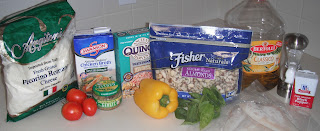Recipe 5: Flounder with Pesto and
Quinoa Salad
My meat and potatoes
husband noted this to be one of his favorite meals. I love it because its done
in 15 minutes.
(serves 2, 600 calories per person)
2 fillets of flounder
(I purchase giant bags of individual fillets in the frozen section of Sam’s
Club. Usually 12 fillets for $9)
(pesto)
Fresh basil
1 tablespoon Garlic
Less than ¼ cup Almonds
(or any nut)
3-4 tablespoons Olive
oil
¼ cup Pecorino romano (or parmesan cheese. I buy large bags at Sam’s
and freeze it)
(quinoa salad)
½ cup Quinoa
Roma tomatoes
Bell Pepper
1 cup Chicken Broth
(low sodium preferred)
Almonds (or any
nut)
(all recipes are originals created by Brittney Owens and are
not to be reproduced)
Directions:
(fish)
Place fish in a nonstick skillet and cook on medium to
medium high until it flakes easily with a fork. Usually 2-3 minutes per side. (baking
instructions on package can also be followed if preferred) It is not necessary
to salt or pepper the fish. Pecorino romano (or parmesan) both have a salty
bite to them. So your pesto topping will suffice as seasoning.
(pesto) Combine basil, 1 dash of salt and pepper, garlic, almonds,
cheese, and olive oil in food processor and blend to desired consistency. I
leave mine slightly chunky but if fully blended it becomes a beautiful green,
creamy sauce. You can make it in bulk and store in the fridge for a week,
adding it to chicken or pasta.
(quinoa)
Add 1 cup chicken broth to saucepan and bring to boil. Add ½
cup quinoa to pot and reduce to simmer. Allow to cook for 10-15 minutes until
all liquid is absorbed. The seed becomes translucent when cooked. Add chopped
bell pepper, chopped tomato, and a small handful of nuts to quinoa. Toss and
serve fish on top.
What will you gain by eating this
meal? (sources http://www.webmd.com and
www.livestrong.com) and “99 Superfoods” by Carrie May
Fish: flounder is
a high protein, high selenium, high omega-3 fish. It is popular for being low
calorie and low mercury. Selenium may help treat and prevent prostate cancer.
There have been studies correlating low selenium levels with coronary disease. In
addition, selenium helps improve your immune system. Strong immune systems mean
you will fight off viral infections ranging from colds to cancer.
Quinoa: The way I
would describe the flavor and texture of quinoa would be if rice and pasta fell
in love and had a super baby. It compares so greatly to a small pasta but
contains an amazing amount of insoluble fiber (the fiber that helps you have
regular bowel movements), iron, protein, and folate. It is often recommend to
vegans and vegetarians. It is also gluten free. I cook it in low sodium chicken
stock to add flavor but it is also very good when cooked in water.
Tomato: are rich
in lycopene, which is a carotenoid. Fruits and vegetables rich in carotenoids
are bright red. Lycopene will reduce your risk of developing osteoporosis and
help prevent macular degeneration. Truthfully a tomato contains more vitamins
and nutrients than l can fully list and the benefits of eating them on a
regular basis are phenomenal. Carrie May outlines them in her book “99
superfoods” which l would recommend.
Bell Pepper:
contain carotenoids. Red peppers contain more antioxidants than any other
color, such as lycopene. You can spot veggies and fruits that contain lycopene
by their red skin. Lycopene (according to Medical news today and other sources)
can help prevent prostate cancer. Lycopene as also been associated with
decreased risk of cardiovascular disease and macular degeneration (eye)
according to Mayoclinic.com
Garlic: Source of
selenium, manganese, vitamin c, B6. Selenium is thought to protect cells from
damage. Manganese is important for bone formation, connective tissue, and blood
clotting. Manganese deficiency is linked to infertility, weakness, seizures,
and bone malformation. B6 helps to realease energy your body stores.
Olive Oil:
Omega-9 fatty acid which helps reduce the risk of heart disease
Almonds: Almonds
provide vitamin E, calcium, iron, magnesium, and phytosterols.
Phytosterols occur naturally in plants
and help to lower cholesterol. This article fully explains how adding
photosterol rich foods can reduce your risk of heart attack or stroke. http://www.livestrong.com/article/118360-phytosterols-cholesterol-lowering/
Basil: Contains
antioxidants, beta carotene, vitamin c, iron, calcium, and potassium. Vitamin C
boosts the body’s immune system and wards off cardiovascular disease, prenatal
health problems, eye disease, and skin wrinkling. Beta carotene converts to vitamin
A in the body. It improves eye health. Deficiency in Vitamin A can cause
reproductive problems. Iron is necessary
to produce new red blood cells, and calcium helps to build strong bones.
Potassium moderates your metabolism and aids in healthy kidney function.



No comments:
Post a Comment